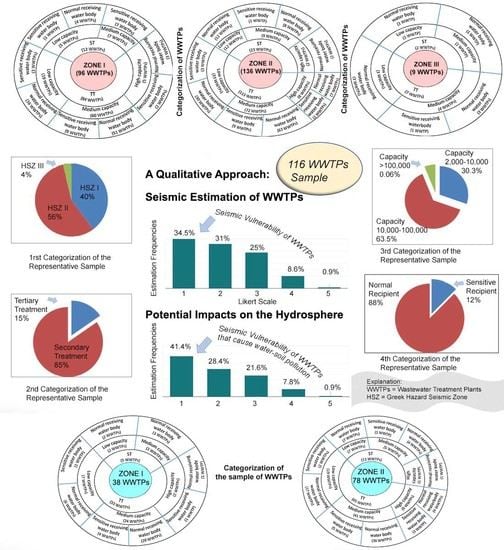A Qualitative Approach to the Seismic Estimation of Wastewater Treatment Plants and Potential Impacts on the Hydrosphere
Abstract
1. Introduction
2. Potential Impacts on the Hydrosphere
3. Methodology
3.1. Application of the Experts Judgement Method
3.2. Representative Sample
Percentages of the Statistical Population of WWTPs
3.3. The Questionnaire
3.4. Recipients of the Questionnaire
3.5. Pilot and Primary Survey
4. Results and Discussion
4.1. Validity and Reliability
4.2. Descriptive Statistics
- (a)
- (b)
- Part 2: Structural vulnerability is presented in Figure 8. It was noticed that, after the year 2000, new anti-seismic codes were implemented for the structures in Greece.
- (c)
- Part 3: NSV parameters and their estimation from the recipients during the post-seismic period are presented in Figure 9.
- (d)
- Part 4: OV characteristics of WWTPs and their estimation by the recipients are shown in Figure 10.
- (e)
- Part 5: Soil–water parameters estimate the seismic vulnerability during the first 24 h after the main seismic strike (Figure 11).
- (f)
- Part 6: The recipients compared the three types of vulnerability (SV, NSV and OV) to each other to obtain coefficients of the variables. Specific questions were distributed to 43 random recipients (37% of the 116 WWTPs) over three months (August to November 2021). Comparing each question of Parts 2–4 with the other questions of the same Part also showed negligible differences (Table 3).
4.3. Synopsis of Main Results
- 34.5% judged that the seismic vulnerability as Class A (which was the only direct question);
- 41.4% judged that the seismic vulnerability can cause soil–water pollution (Class A);
- 32.8% answered that the seismic vulnerability depends on the SV (Class A);
- 49.1% answered that the SV can cause soil–water pollution (Class A);
- 38.8% answered that the seismic vulnerability depends on the NSV (Class B);
- 40.5% answered that the NSV can cause soil–water pollution (Class A);
- 46.6% judged that the OV contributes to soil pollution (Class A);
- 48.3% judged that the OV contributes to water pollution (Class A);
- 40.5% judged that the OV contributes to air pollution (Class A);
- 55.2% answered that the problems of operationality can be attributed to seismic vulnerability (Class A);
- 50.9% answered that seismic vulnerability depends on the OV (Class B);
- 37.9% (Class A) and 39.7% (Class B) judged that the soil–water pollution can be attributed to seismic vulnerability;
- During the 24 h post-seismic period, the degree of soil–water pollution remains constant; and
- 46.5%, 51.2% and 37.2% answered, respectively, that the SV, NSV and OV contribute to seismic vulnerability (Class A).
5. Conclusions
Author Contributions
Funding
Informed Consent Statement
Data Availability Statement
Acknowledgments
Conflicts of Interest
References
- Kassem, M.M.; Nazri, M.F.; Farsangi, N.E. The Seismic Vulnerability Assessment Methodologies: A State-of-the-Art Review. Ain Shams Eng. J. 2020, 11, 849–864. [Google Scholar] [CrossRef]
- Pitilakis, K.; Alexoudi, M.; Argyroudis, S.; Monge, O.; Martin, C. Vulnerability and Risk Assessment of Lifelines. In Assessing and Managing Earthquake Risk; Springer: Berlin/Heidelberg, Germany, 2006; pp. 185–211. [Google Scholar]
- Risk-UE. An Advanced Approach to Earthquake Risk Scenarios with Applications to Different European Towns (RISK-UE)|RISK-UE Project (FP5-CORDIS-European Commission). Available online: https://cordis.europa.eu/project/id/EVK4-CT-2000-00014 (accessed on 20 August 2021).
- Guo, M. Soil Sampling and Methods of Analysis. J. Environ. Qual. 2009, 38, 375. [Google Scholar] [CrossRef]
- Leventakis, G. Security of Systems and Critical Infrastructure. Implementation in Heterogeneous and Interconnected Transport Networks. Ph.D. Thesis, University of Aegean, Mytilene, Greece, 2013. Available online: https://docplayer.gr/16315231-Asfaleia-systimaton-kai-krisimon-ypodomon-efarmogi-se-eterogeni-kai-diasyndedemena-diktya-metaforon.html (accessed on 20 May 2022).
- Alexoudi, M. Contributing to the Analysis of the Seismic Vulnerability of Networks of General Interest in an Urban Environment. Development of an Integrated Seismic Risk Management Methodology. Ph.D. Thesis, Aristotle University of Thessaloniki, Thessaloniki, Greek, 2005. Available online: https://thesis.ekt.gr/thesisBookReader/id/18992?lang=el#page/1/mode/2up (accessed on 20 May 2022).
- EPPO Seismic Vulnerability Assessment Methodology of Existing Bridges. Available online: https://www.oasp.gr/node/2303 (accessed on 27 August 2020).
- Dandoulaki, M. Spatial Planning and Seismic Protection in Greece. Ph.D. Thesis, NTUA, Athens, Greek, 2008. Available online: https://thesis.ekt.gr/thesisBookReader/id/16271#page/1/mode/2up (accessed on 27 August 2021).
- Sapountzaki, K.; Dandoulaki, M. Risks and Disasters. Concepts and Tools for the Evaluation, Protection, Management; Association of Greek Academic Libraries, Kallipos: Zografou, Greek, 2015; Available online: https://repository.kallipos.gr/handle/11419/6297 (accessed on 27 August 2020). (In Greek)
- Animah, I.; Shafiee, M. Application of Risk Analysis in the Liquefied Natural Gas (LNG) Sector: An Overview. J. Loss Prev. Process Ind. 2020, 63, 103980. [Google Scholar] [CrossRef]
- FEMA. Rapid Visual Screening of Buildings for Potentional Seismic Hazards: A Handbook; FEMA: Colombia, WA, USA, 2015. [Google Scholar]
- EPPO Structural Vulnerability Checking. Available online: https://www.oasp.gr/node/76 (accessed on 30 April 2020).
- Kerpelis, P.N.; Golfinopoulos, S.K.; Alexakis, D.E. A Proposed Theoretical Approach for the Estimation of Seismic Structural Vulnerability of Wastewater Treatment Plants. Sustainability 2021, 13, 4835. [Google Scholar] [CrossRef]
- Kerpelis, P. Assessment of Structural and Non-Structural Vulnerability of Sewage Treatment Plants, through a Questionnaire. In Proceedings of the 6th International Conference SafeCorfu 2019, Corfu, Greece, 6–9 November 2019; pp. 133–136. [Google Scholar]
- McFadden, L. An All-Hazard Approach to Building Resilience. In Proceedings of the 6th EWA/JSWA/WEF Joint Conference “The resilience of the Water Sector”, Munich, Germany, 15–18 May 2018; p. 34. [Google Scholar]
- Lin, L.; Yang, H.; Xu, X. Effects of Water Pollution on Human Health and Disease Heterogeneity: A Review. Front. Environ. Sci. 2022, 10, 975. [Google Scholar] [CrossRef]
- Khan, S.; Naushad, M.; Govarthanan, M.; Iqbal, J.; Alfadul, S.M. Emerging Contaminants of High Concern for the Environment: Current Trends and Future Research. Environ. Res. 2022, 207, 112609. [Google Scholar] [CrossRef]
- Khan, S.; Naushad, M.; Al-Gheethi, A.; Iqbal, J. Engineered Nanoparticles for Removal of Pollutants from Wastewater: Current Status and Future Prospects of Nanotechnology for Remediation Strategies. J. Environ. Chem. Eng. 2021, 9, 106160. [Google Scholar] [CrossRef]
- Khan, S.; Naushad, M.; Lima, E.C.; Zhang, S.; Shaheen, S.M.; Rinklebe, J. Global Soil Pollution by Toxic Elements: Current Status and Future Perspectives on the Risk Assessment and Remediation Strategies—A Review. J. Hazard. Mater. 2021, 417, 126039. [Google Scholar] [CrossRef]
- Khan, S.; Dan, Z.; Mengling, Y.; Yang, Y.; Haiyan, H.; Hao, J. Isotherms, Kinetics and Thermodynamic Studies of Adsorption of Ni and Cu by Modification of Al2O3 Nanoparticles with Natural Organic Matter. Fuller. Nanotub. Carbon Nanostruct. 2018, 26, 158–167. [Google Scholar] [CrossRef]
- Special Secretariat of Water WTPs—Database for Monitoring of Operation. Available online: http://astikalimata.ypeka.gr/Services/Pages/WtpViewApp.aspx (accessed on 5 September 2021).
- Association of Municipal Water and Sewerage Companies Catalog of Municipal Companies of Water and Sewage (DEYA). Available online: https://www.edeya.gr/ (accessed on 21 July 2021).
- EEA Interactive Maps and Data Viewers by Category—European Environment Agency. Available online: https://www.eea.europa.eu/themes/water/european-waters/water-use-and-environmental-pressures/uwwtd/data-viewer-urban-wastewater-treatment-directive-1/urban-waste-water-directive-treatment (accessed on 18 October 2020).
- EEA Waterbase-UWWTD: Urban Waste Water Treatment Directive. Available online: https://www.eea.europa.eu/data-and-maps/data/waterbase-uwwtd-urban-waste-water-treatment-directive-6 (accessed on 21 October 2020).
- Openquake Recording of Earthquake Impacts-Athens 1999. Available online: https://platform.openquake.org/ecd/eventdetails/21?studyid=0&f_b=False&f_c=False&f_i=True&f_p=False&f_s=False&all=False (accessed on 10 August 2022).
- EEA-Discomap. European Environment Agency. Available online: https://discomap.eea.europa.eu/Index/ (accessed on 19 October 2020).
- Panico, A.; Lanzano, G.; Salzano, E.; Santucci De Magistris, F.; Fabbrocino, G. Seismic Vulnerability of Wastewater Treatment Plants. Chem. Eng. Trans. 2013, 32, 13–18. [Google Scholar]
- Farokhnia, K.; Porter, K. Estimating the Non-Structural Seismic Vulnerability of Building Categories. In Proceedings of the 15th World Conference on Earthquake Engineering, Lisbon, Portugal, 24–28 September 2012; Volume 10. [Google Scholar]
- Stamatakis, A. Seismic Vulnerability of Water and Sewage Networks. Bachelor’s Thesis, NTUA, Athens, Greek, 2012. Available online: https://dspace.lib.ntua.gr/xmlui/handle/123456789/5934 (accessed on 20 October 2021).
- Fabiyi, M. Characterizing Air Emissions from Wastewater Facilities. In Proceedings of the 23rd International Petroleum Environmental Conference; Hydromantis Environmental Software Solutions, New Orleans, LA, USA, 8–10 November 2016; p. 29. [Google Scholar]
- Schiff, A.J.; Tang, A.K. Chi-Chi, Taiwan, Earthquake of September 21, 1999: Lifeline Performance; ASCE: Reston, VA, USA, 2000; p. 222. [Google Scholar]
- Tang, A.K.; Eng, P.; Eng, C.; Asce, F. Lifelines Performance of the Mw 8.8 off Shore Biobío, Chile Earthquake. Procedia Eng. 2011, 14, 922–930. [Google Scholar] [CrossRef]
- Zare, M.R.; Wilkinson, S.; Potangaroa, R. Earthquake Damage in Wastewater Systems and Postearthquake Repair Methods; Limitation and Practice. In Proceedings of the Australian Earthquake Engineering Society Conference, Barossa Valley, Australia, 1–2 January 2011. [Google Scholar]
- Donohue, S.; McCarthy, V.; Rafferty, P.; Orr, A.; Flynn, R. Geophysical and Hydrogeological Characterisation of the Impacts of On-Site Wastewater Treatment Discharge to Groundwater in a Poorly Productive Bedrock Aquifer. Sci. Total Environ. 2015, 523, 109–119. [Google Scholar] [CrossRef] [PubMed]
- Alexakis, D. Human Health Risk Assessment Associated with Co, Cr, Mn, Ni and V Contents in Agricultural Soils from a Mediterranean Site. Arch. Agron. Soil Sci. 2016, 62, 359–373. [Google Scholar] [CrossRef]
- Alexakis, D.; Gamvroula, D.; Theofili, E. Environmental Availability of Potentially Toxic Elements in an Agricultural Mediterranean Site. Environ. Eng. Geosci. 2019, 25, 169–178. [Google Scholar] [CrossRef]
- Alexakis, D.E. Contaminated Land by Wildfire Effect on Ultramafic Soil and Associated Human Health and Ecological Risk. Land 2020, 9, 409. [Google Scholar] [CrossRef]
- Alexakis, D.E.; Bathrellos, G.D.; Skilodimou, H.D.; Gamvroula, D.E. Spatial Distribution and Evaluation of Arsenic and Zinc Content in the Soil of a Karst Landscape. Sustainability 2021, 13, 6976. [Google Scholar] [CrossRef]
- Alexakis, D.E.; Bathrellos, G.D.; Skilodimou, H.D.; Gamvroula, D.E. Land Suitability Mapping Using Geochemical and Spatial Analysis Methods. Appl. Sci. 2021, 11, 5404. [Google Scholar] [CrossRef]
- Clark, C.S.; Cleary, E.J.; Schiff, G.M.; Linneman, C.C.; Phair, J.P.; Briggs, T.M. Disease Risks of Occupational Exposure to Sewage. J. Environ. Eng. Div. 1976, 102, 375–388. [Google Scholar] [CrossRef]
- Walters, R.J.; Zoback, M.D.; Baker, J.W.; Beroza, G.C. Characterizing and Responding to Seismic Risk Associated with Earthquakes Potentially Triggered by Fluid Disposal and Hydraulic Fracturing. Seismol. Res. Lett. 2015, 86, 1110–1118. [Google Scholar] [CrossRef]
- Lindell, M.K.; Perry, R.W. Hazardous Materials Releases in the Northridge Earthquake: Implications for Seismic Risk Assessment. Risk Anal. 1997, 17, 147–156. [Google Scholar] [CrossRef]
- Ivanković, T.; Hrenović, J. Surfactants in the Environment. Arh. Hig. Rada Toksikol. 2010, 61, 95–110. [Google Scholar] [CrossRef] [PubMed]
- Zhang, Z.; Chen, Y. Effects of Microplastics on Wastewater and Sewage Sludge Treatment and Their Removal: A Review. Chem. Eng. J. 2020, 382, 122955. [Google Scholar] [CrossRef]
- Calvi, G.M.; Pinho, R.; Magenes, G.; Bommer, J.J.; Restrepo-Velez, L.F.; Crowley, H. Development of Seismic Vulnerability Assessment Methodologies over the Past 30 Years. ISET J. Earthq. Technol. 2006, 43, 75–104. [Google Scholar]
- Whitman, R.V.; Biggs, J.M.; Cornell, C.A.; Brennan, J.E.; de Neufville, R.L.; Vanmarcke, E.H. Seismic Design Decision Analysis. J. Struct. Div. 1975, 101, 1067–1084. [Google Scholar] [CrossRef]
- Kappos, A.J.; Panagopoulos, G.; Panagiotopoulos, C.; Penelis, G. A Hybrid Method for the Vulnerability Assessment of R/C and URM Buildings. Bull. Earthq. Eng. 2006, 4, 391–413. [Google Scholar] [CrossRef]
- Panagopoulos, G.; Kappos, A. Developing a Uniform Statistical Data Base on Buildings, from Greek Earthquakes and Its Use for Mapping of the Vulnerability Curves. In Proceedings of the 16th Concrete Conference, Paphos, Cyprus, 21–23 October 2009; p. 14. Available online: http://library.tee.gr/digital/m2456/m2456_contents.htm (accessed on 20 October 2021).
- GEM OpenQuake-Global Seismic Risk Map_Annual Losses. Available online: https://maps.openquake.org/map/global-seismic-risk-map/#3/31.93/-2.00 (accessed on 19 August 2021).
- GEM. GEM-Global Risk Map_v2018.1. Available online: https://cloud-storage.globalquakemodel.org/public/Global%20Maps/GEM_Global_Risk_Map_v2018.1-CCBY.png (accessed on 19 August 2021).
- Dimopoulos, K.; Tinga, K.; Sagias, I. Spatial and Structural Effects of Earthquakes in the City. The Case of Athens. In Proceedings of the Cities of the Mediterranean, 50 Years after the Catastrophic Earthquakes in Thessaly, Volos, Greek, 12–14 May 2006; Available online: https://docplayer.gr/12498955-Horikes-kai-domikes-epiptoseis-ton-seismon-stin-poli-i-periptosi-tis-athinas-1.html (accessed on 10 October 2021).
- EPPO-ACEG (Ed.) Greek Code for Seismic Resistant Structures-EAK2000, 2001st ed.; EPPO: Athens, Greek, 2001. [Google Scholar]
- Available online: http://www.et.gr/api/DownloadFeksApi/?fek_pdf=20030201154 (accessed on 19 August 2022).
- CSS Educations from the Center for Security Studies. Available online: http://www.kemea.gr/el/ekpaidefsi/programmata-ekpaidefsis?limit=10 (accessed on 30 May 2022).
- EPPO Inspection of Structural Vulnerability. Available online: https://www.oasp.gr/node/76 (accessed on 5 July 2021).
- Alexoudi, M.; Pitilakis, K.; Souli, A. SYNER-G Deliverable D3. 5: Fragility Functions for Water and Wastewater System Elements; Aristotle University of Thessaloniki: Thessaloniki, Greece, 2010. [Google Scholar]
- Tyagi, S.; Garg, N.; Paudel, R. Environmental Degradation: Causes and Consequences. Eur. Res. 2014, 81, 1491. [Google Scholar] [CrossRef]
- Dinka, M.O. Safe Drinking Water: Concepts, Benefits, Principles and Standards. In Water Challenges of an Urbanizing World; InTech: Rijeka, Croatia, 2018. [Google Scholar]
- Afolalu, S.A.; Ikumapayi, O.M.; Ogedengbe, T.S.; Kazeem, R.A.; Ogundipe, A.T. Waste Pollution, Wastewater and Effluent Treatment Methods—An Overview. Mater. Today Proc. 2022, 62, 3282–3288. [Google Scholar] [CrossRef]
- Srinivas, H.; Nakagawa, Y. Environmental Implications for Disaster Preparedness: Lessons Learnt from the Indian Ocean Tsunami. J. Environ. Manag. 2008, 89, 4–13. [Google Scholar] [CrossRef]
- Du, P.; Chen, J.; Chen, C.; Liu, Y.; Liu, J.; Wang, H.; Zhang, X. Environmental Risk Evaluation to Minimize Impacts within the Area Affected by the Wenchuan Earthquake. Sci. Total Environ. 2012, 419, 16–24. [Google Scholar] [CrossRef]
- Knudson, M.; Ballantyne, D.; Stuhr, M.; Damewood, M. The Oregon Resilience Plan for Water and Wastewater Systems. In Proceedings of the Pipelines 2014, Portland, OR, USA, 3–6 August 2014; American Society of Civil Engineers: Reston, VA, USA, 2014; pp. 2211–2220. [Google Scholar]
- Thevenon, F.; Poté, J. Water Pollution History of Switzerland Recorded by Sediments of the Large and Deep Perialpine Lakes Lucerne and Geneva. Water. Air. Soil Pollut. 2012, 223, 6157–6169. [Google Scholar] [CrossRef]
- Nikolaou, A.D.; Golfinopoulos, S.K.; Kostopoulou, M.N.; Kolokythas, G.A.; Lekkas, T.D. Determination of Volatile Organic Compounds in Surface Waters and Treated Wastewater in Greece. Water Res. 2002, 36, 2883–2890. [Google Scholar] [CrossRef]
- WHO. Chemical Releases Associated with Earthquakes; WHO: Geneva, Switzerland, 2018; Available online: https://www.who.int/publications/i/item/WHO-CED-PHE-EPE-18.01 (accessed on 30 May 2022).
- Zhang, Q.H.; Yang, W.N.; Ngo, H.H.; Guo, W.S.; Jin, P.K.; Dzakpasu, M.; Yang, S.J.; Wang, Q.; Wang, X.C.; Ao, D. Current Status of Urban Wastewater Treatment Plants in China. Environ. Int. 2016, 92, 11–22. [Google Scholar] [CrossRef] [PubMed]
- D’Inverno, G.; Carosi, L.; Romano, G.; Guerrini, A. Water Pollution in Wastewater Treatment Plants: An Efficiency Analysis with Undesirable Output. Eur. J. Oper. Res. 2018, 269, 24–34. [Google Scholar] [CrossRef]
- Samios, S.; Golfinopoulos, S. Natural Organic Matter Characterization by HPSEC and Its Contribution to CBPs Formation in Athens Water Supply Network. Implications for Alternative Disinfectants Use. In Proceedings of the 14th International Conference on Environmental Science and Technology, Rhodes, Greece, 3–5 September 2015. Poster B51. [Google Scholar]
- Sen, B.; Alp, M.T.; Sonmez, F.; Kocer Turan, M.A.; Conpolat, O. Relationship of Algae to Water Pollution and Waste Water Treatment. In Water Treatment; Elshorbagy, W., Chowdhury, K.R., Eds.; IntechOpen: Rijeka, Croatia, 2013; p. 335. ISBN 978-953-51-0928-0. [Google Scholar]
- Bunzel, K.; Kattwinkel, M.; Liess, M. Effects of Organic Pollutants from Wastewater Treatment Plants on Aquatic Invertebrate Communities. Water Res. 2013, 47, 597–606. [Google Scholar] [CrossRef]
- Chambers, P.A.; Allard, M.; Walker, S.L.; Marsalek, J.; Lawrence, J.; Servos, M.; Busnarda, J.; Munger, K.S.; Adare, K.; Jefferson, C.; et al. Impacts of Municipal Wastewater Effluents on Canadian Waters: A Review. Water Qual. Res. J. Can. 1997, 32, 659–713. [Google Scholar] [CrossRef]
- Zare, M.R.; Wilkinson, S.; Potangaroa, R. Vulnerability of Wastewater Treatment Plants and Wastewater Pumping Stations to Earthquakes. Int. J. Strateg. Prop. Manag. 2010, 14, 408–420. [Google Scholar] [CrossRef]
- Schwab, J.C. Hazard Mitigation: Integrating Best Practices into Planning; American Planning Association: Chicago, IL, USA, 2010. [Google Scholar]
- Bragato, D.D.A. Downtime Estimation of Lifelines after an Earthquake; University of California: Berkeley, CA, USA, 2016. [Google Scholar]
- Schiff, A.J. Hyogoken-Nanbu (Kobe) Earthquake of 17 January 1995: Lifeline Performance; ASCE: Reston, VA, USA, 1999; ISBN 978-0-7844-0408-9. [Google Scholar]
- Malakootian, M.; Nouri, J. Chemical Variations of Ground Water Affected by the Earthquake in Bam Region Malakootian, M. Int. J. Environ. Res. 2010, 4, 443–454. [Google Scholar] [CrossRef]
- Rossetto, T.; Peiris, N.; Pomonis, A.; Wilkinson, S.M.; Del Re, D.; Koo, R.; Gallocher, S. The Indian Ocean Tsunami of December 26, 2004: Observations in Sri Lanka and Thailand. Nat. Hazards 2007, 42, 105–124. [Google Scholar] [CrossRef]
- Kongar, I.; Esposito, S.; Giovinazzi, S. Post-Earthquake Assessment and Management for Infrastructure Systems: Learning from the Canterbury (New Zealand) and L’Aquila (Italy) Earthquakes. Bull. Earthq. Eng. 2017, 15, 589–620. [Google Scholar] [CrossRef]
- Evans, N.L.; McGhie, C. The Performance of Lifeline Utilities Following the 27th February 2010 Maule Earthquake Chile. In Proceedings of the 9th Pacific Conference on Earthquake Engineering “Building an Earthquake-Resilient Society”, NZSEE, Auckland, New Zealand, 14–16 April 2011; p. 8. [Google Scholar]
- Devane, M.L.; Moriarty, E.M.; Wood, D.; Webster-Brown, J.; Gilpin, B.J. The Impact of Major Earthquakes and Subsequent Sewage Discharges on the Microbial Quality of Water and Sediments in an Urban River. Sci. Total Environ. 2014, 485, 666–680. [Google Scholar] [CrossRef]
- Qi, W.K.; Sanuba, T.; Norton, M.; Li, Y.Y. Effect of the Great East Japan Earthquake and Tsunami on Sewage Facilities and Subsequent Recovery Measures. Water Sustain. 2014, 4, 27–40. [Google Scholar]
- Ishii, E.; Watanabe, Y.; Agusa, T.; Hosono, T.; Nakata, H. Acesulfame as a Suitable Sewer Tracer on Groundwater Pollution: A Case Study before and after the 2016 Mw 7.0 Kumamoto Earthquakes. Sci. Total Environ. 2021, 754, 142409. [Google Scholar] [CrossRef] [PubMed]
- Robson, C. Real World Research—A Tool for Social Scientists and Professional Researchers; Gutenberg: Athens, Greek, 2010. [Google Scholar]
- Kirchhoff, C.J.; Watson, P.L. Are Wastewater Systems Adapting to Climate Change? JAWRA J. Am. Water Resour. Assoc. 2019, 55, 869–880. [Google Scholar] [CrossRef]
- Darakas, E. Waste Treatment Processes; AUTH: Thessaloniki, Greece, 2010; Available online: https://docplayer.gr/30986395-Diergasies-epexergasias-ygron-apovliton.html (accessed on 26 November 2021). (In Greek)
- Keeney, R.L.; McDaniels, T.L.; Ridge-Cooney, V.L. Using Values in Planning Wastewater Facilities for Metropolitan Seattle. J. Am. Water Resour. Assoc. 1996, 32, 293–303. [Google Scholar] [CrossRef]
- Blanco-Londoño, S.A.; Torres-Lozada, P.; Galvis-Castaño, A. Identification of Resilience Factors, Variables and Indicators for Sustainable Management of Urban Drainage Systems. DYNA 2017, 84, 126–133. [Google Scholar] [CrossRef]
- Stamatiou, K.; Tsafou, S. Rapid Vulnerability Assessment of Public Building Stock. Thessis NTUA. 2013. Available online: https://docplayer.gr/12959083-Taheia-apotimisi-trototitas-ktiriakoy-apothematos-dimosias-hriseos.html (accessed on 2 June 2021). (In Greek).
- Manikas, P. Damages to Structural and Non-Structural Elements of an Earthquake. Types and Factors Affecting Buildings. Thessis UOA. 2018. Available online: https://pergamos.lib.uoa.gr/uoa/dl/frontend/file/lib/default/data/2672649/theFile (accessed on 26 November 2021). (In Greek).
- O’Rourke, M.J.; Liu, X. Response of Buried Pipelines Subject to Earthquake Effects; MCEE, University of Buffalo: New York, NY, USA, 1999. [Google Scholar]
- Karidis, P.; Lekkas, E. Development of Guidelines for the Safer Handling of Seismic Risks in Factory Premises; ELINYAE: Athens, Greek, 2008. [Google Scholar]
- EPPO Non Structural Vulnerability Checking. Available online: https://www.oasp.gr/node/159 (accessed on 15 May 2022).
- Prathivadi, K. Wastewater Resilience Planning. In Proceedings of the 6th EWA/JSWA/WEF Joint Conference “The Resilience of the Water Sector”, Munich, Germany, 15–18 May 2018. [Google Scholar]
- Kerpelis, P.; Golfinopoulos, S.; Alexakis, D. Proposing the Critical Structural Characteristics of Wastewater Treatment Plants (WTPs) for the Estimation of Their Seismic Vulnerability. In Proceedings of the International Conference VSU2020, Sofia, Bulgary, 15–17 October 2020; pp. 825–830. [Google Scholar]
- Kerpelis, P.; Biba, E. A Seismic Vulnerability Questionnaire for WWTPs. Available online: https://docs.google.com/forms/d/e/1FAIpQLScJHiNzjLVdxhVTYwDDGFRtsSOyp7stVkOoXynSM3MIbGF18Q/viewform (accessed on 26 November 2021).
- Vicente, R.; Lagomarsino, S.; Mendes Silva, R. Seismic Vulnerability Assessment, Damage Scenarios and Loss Estimation. Case Study of the Old City Centre of Coimbra, Portugal. In Proceedings of the 14th World Conference on Earthquake Engineering, Beijing, China, 12–17 October 2008; p. 9. [Google Scholar]
- Oppenheim, A.N. Questionnaire Design, Interviewing and Attitude Measurement; Bloomsbury Publishing: London, UK, 2000; ISBN 0826451764. [Google Scholar]
- Thabane, L.; Ma, J.; Chu, R.; Cheng, J.; Ismaila, A.; Rios, L.P.; Robson, R.; Thabane, M.; Giangregorio, L.; Goldsmith, C.H. A Tutorial on Pilot Studies: The What, Why and How. BMC Med. Res. Methodol. 2010, 10, 1–10. [Google Scholar] [CrossRef] [PubMed]
- Galanis, P. Validity and Reliability of Questionnaires in Epidemiological Studies. Arch. Hell. Med. 2013, 30, 97–110. [Google Scholar]
- Robinson, J.; Shaver, P.; Wrightsman, L. Measures of Personality and Social Psychological Attitudes; Academic Press: Cambridge, MA, USA, 1991. [Google Scholar]
- Nunnally, J.C. An Overview of Psychological Measurement. In Clinical Diagnosis of Mental Disorders; Wolman, B.B., Ed.; Springer: Boston, MA, USA, 1978. [Google Scholar] [CrossRef]
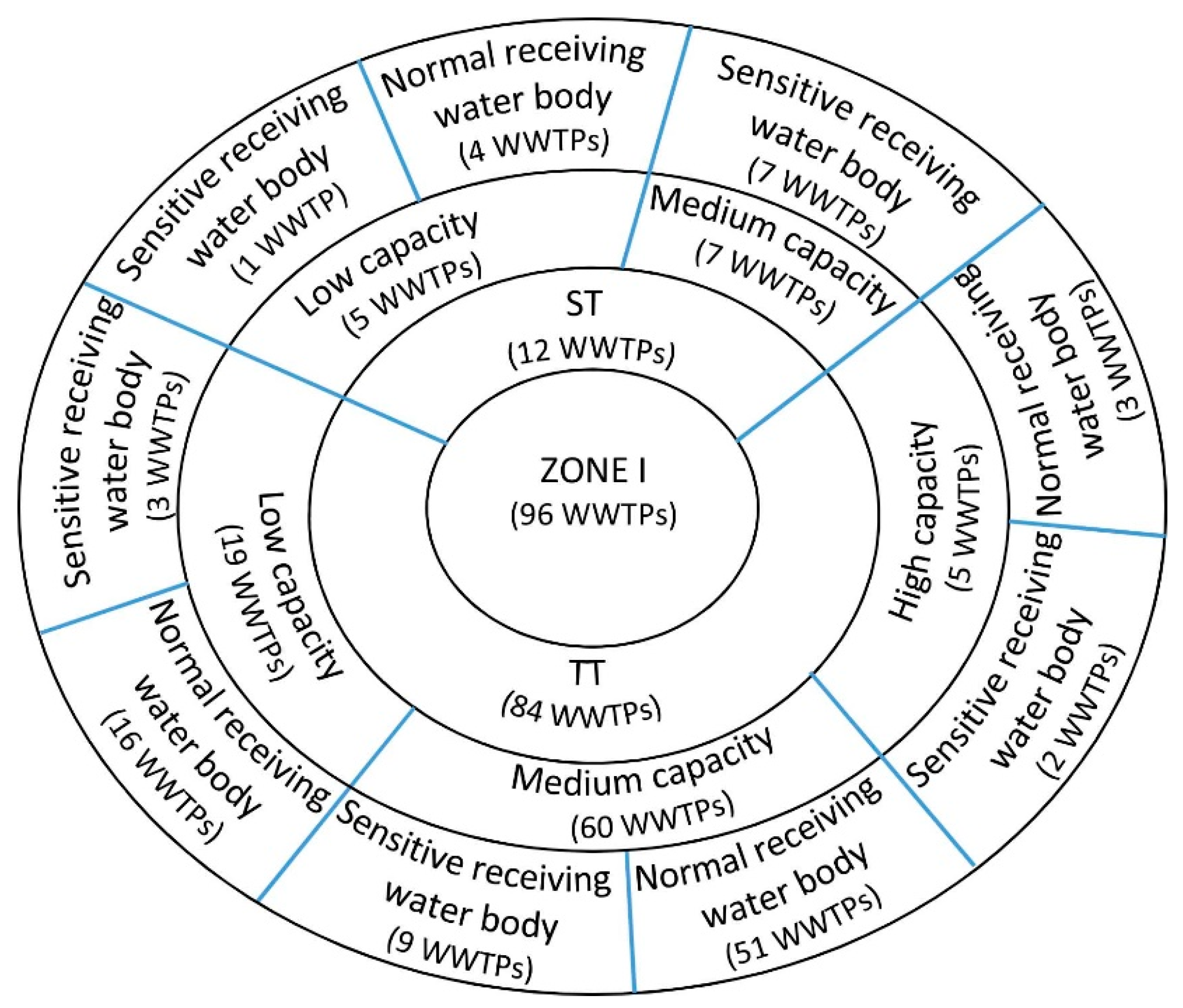
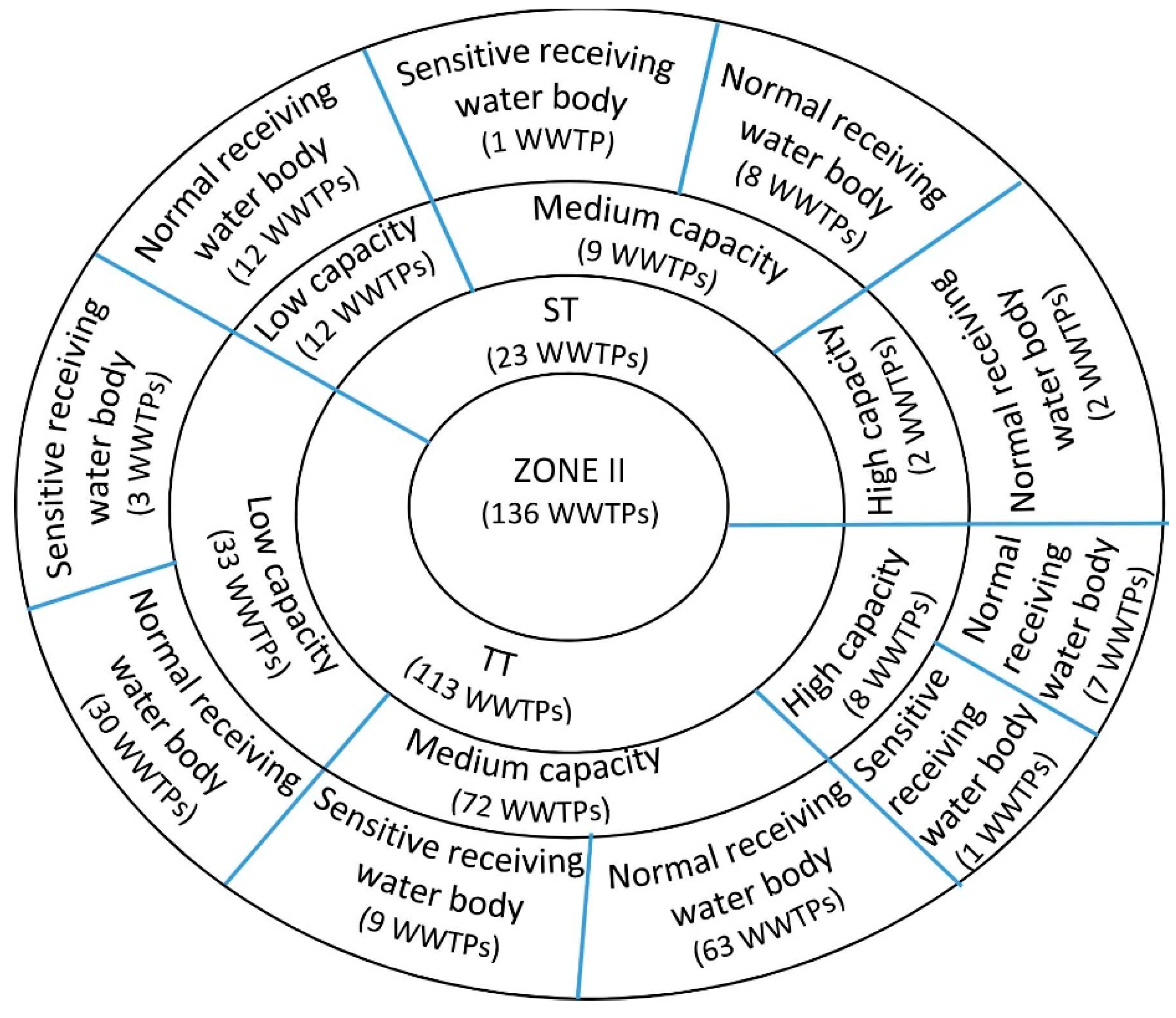
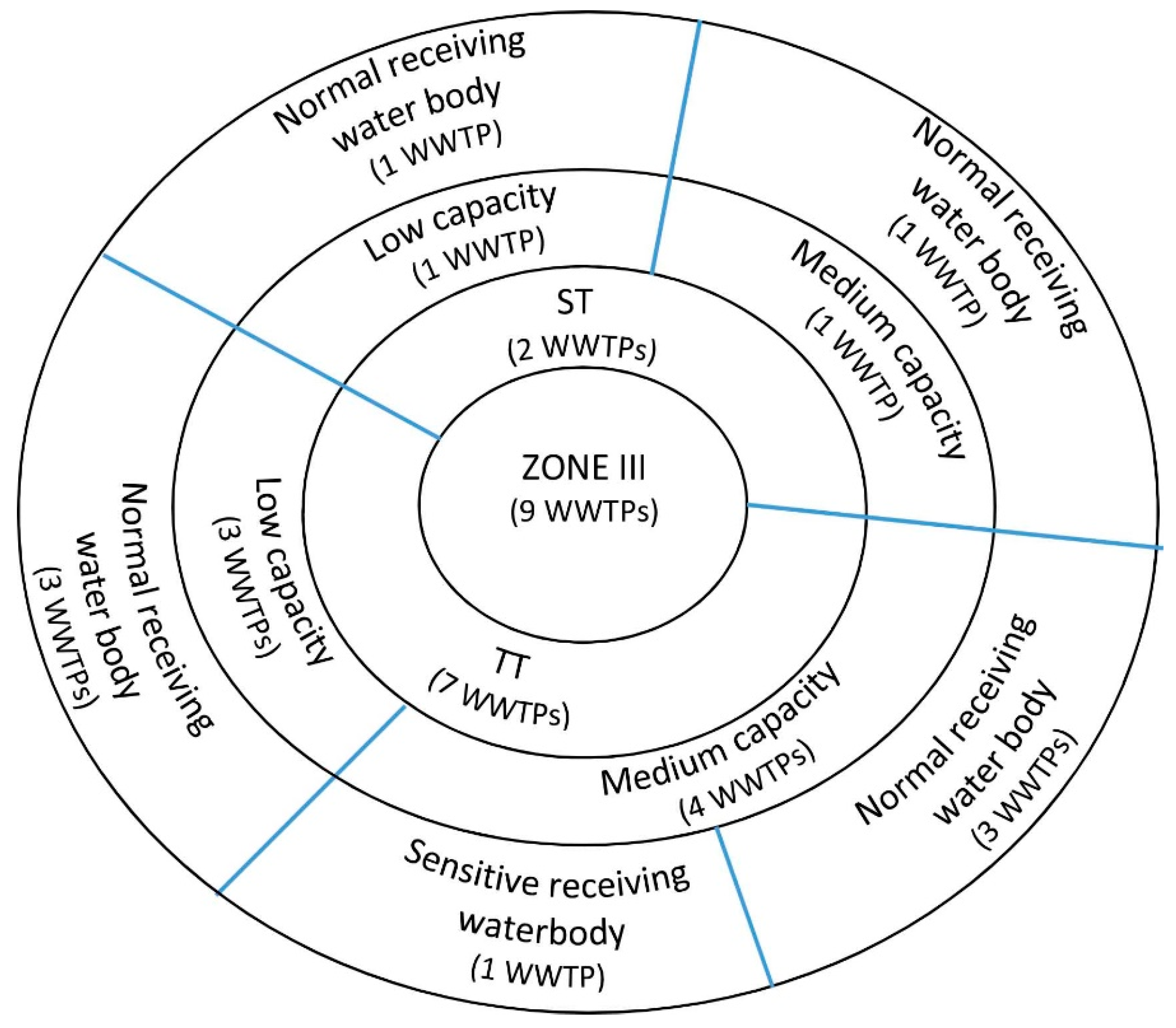
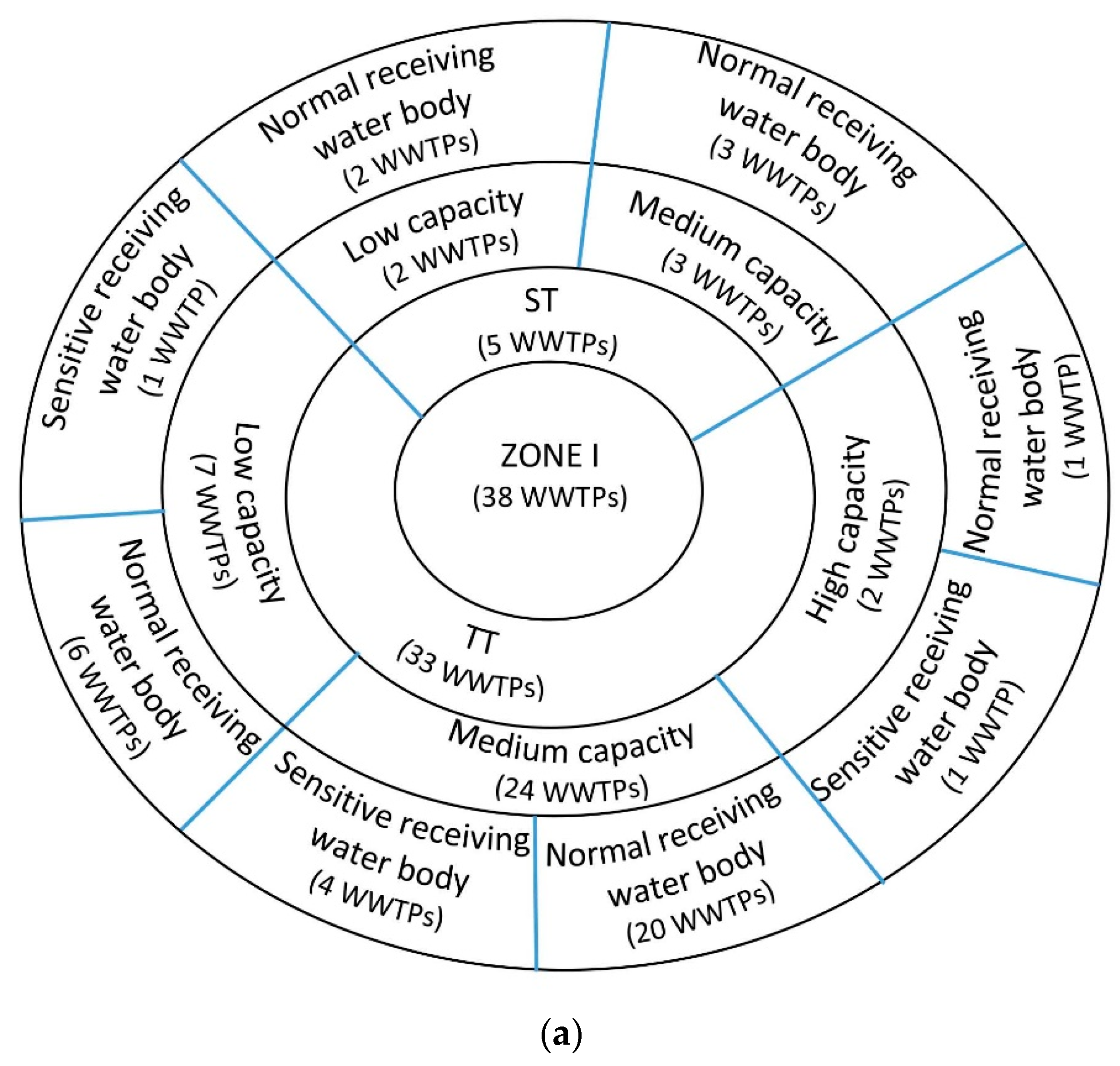
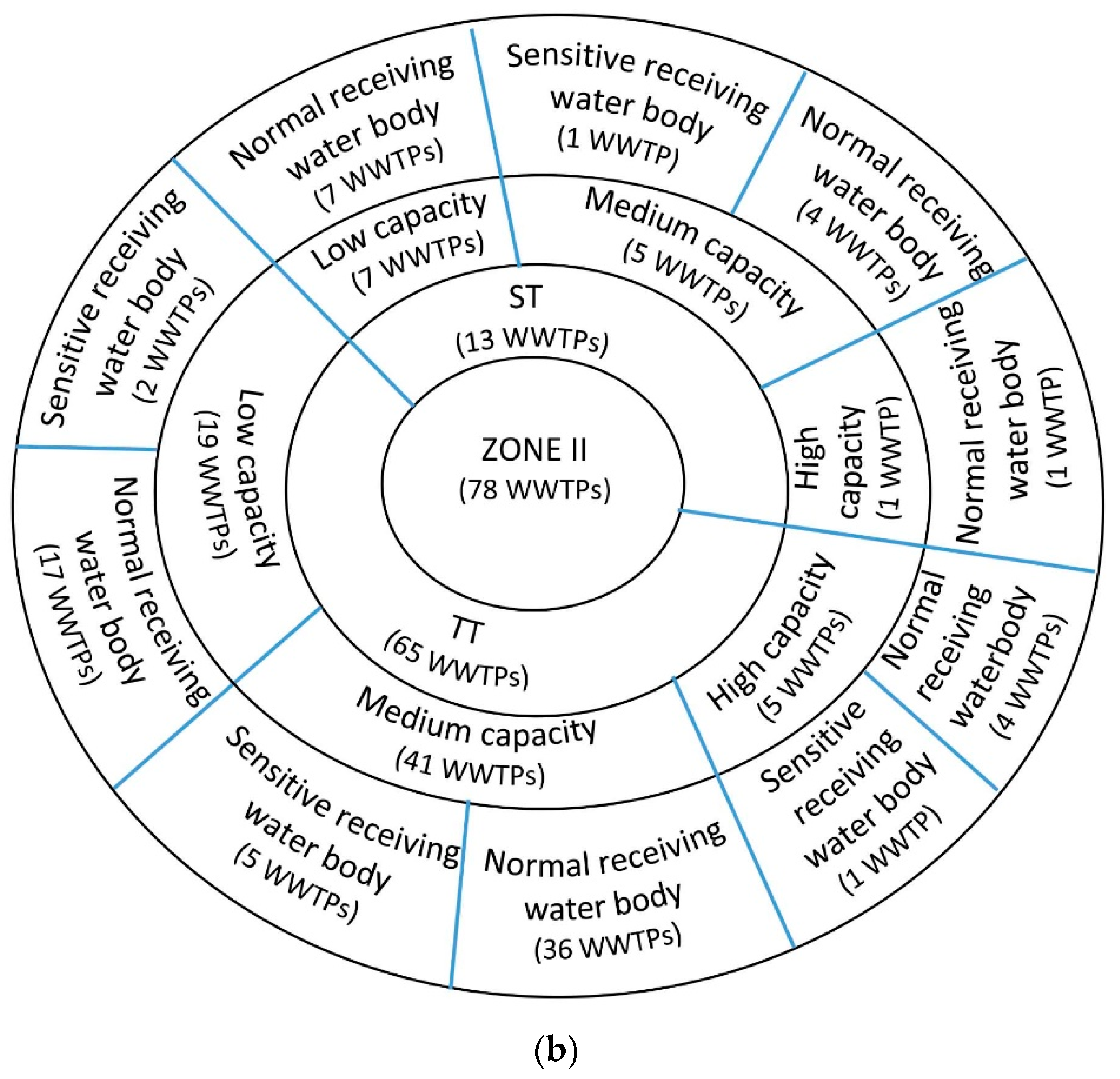
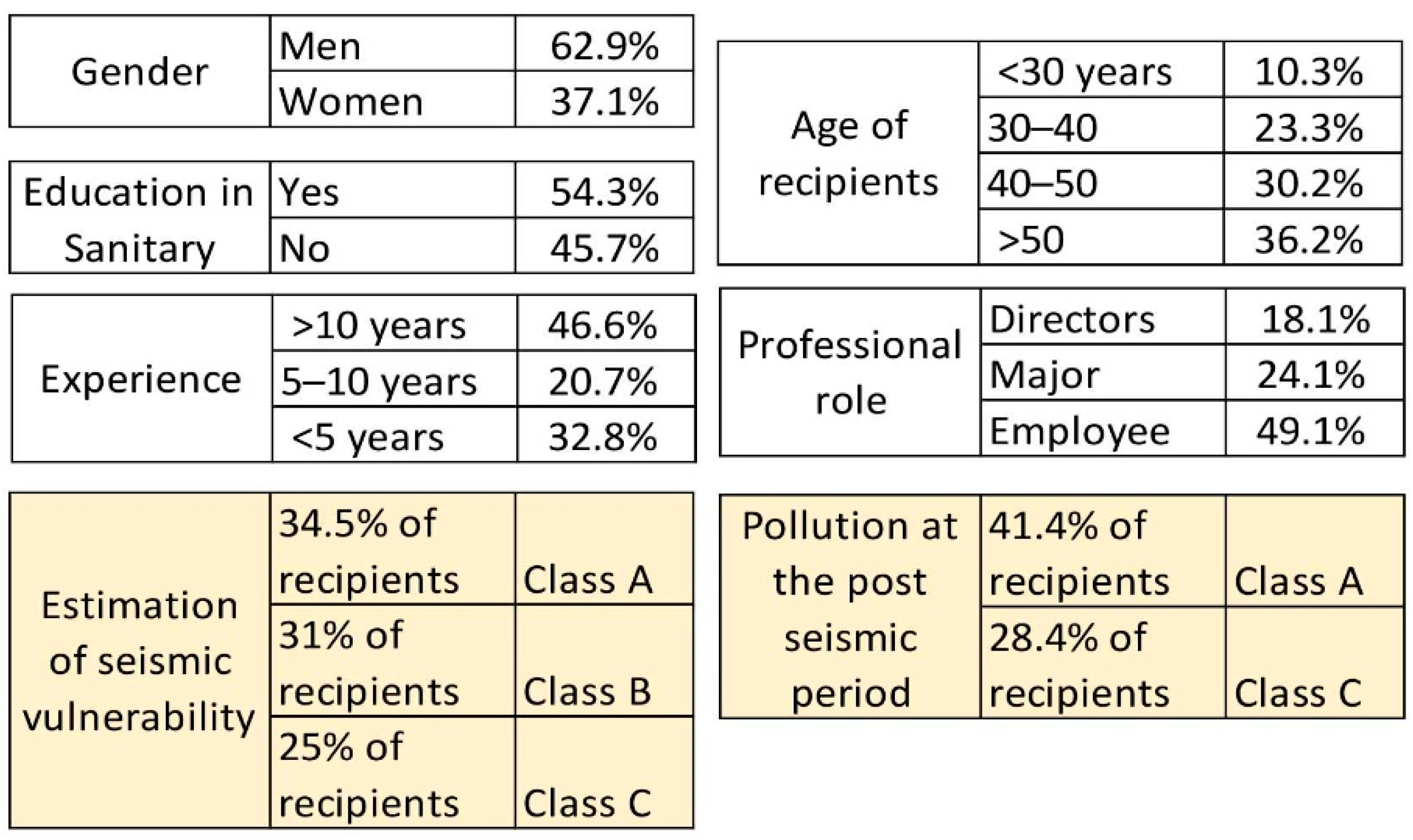
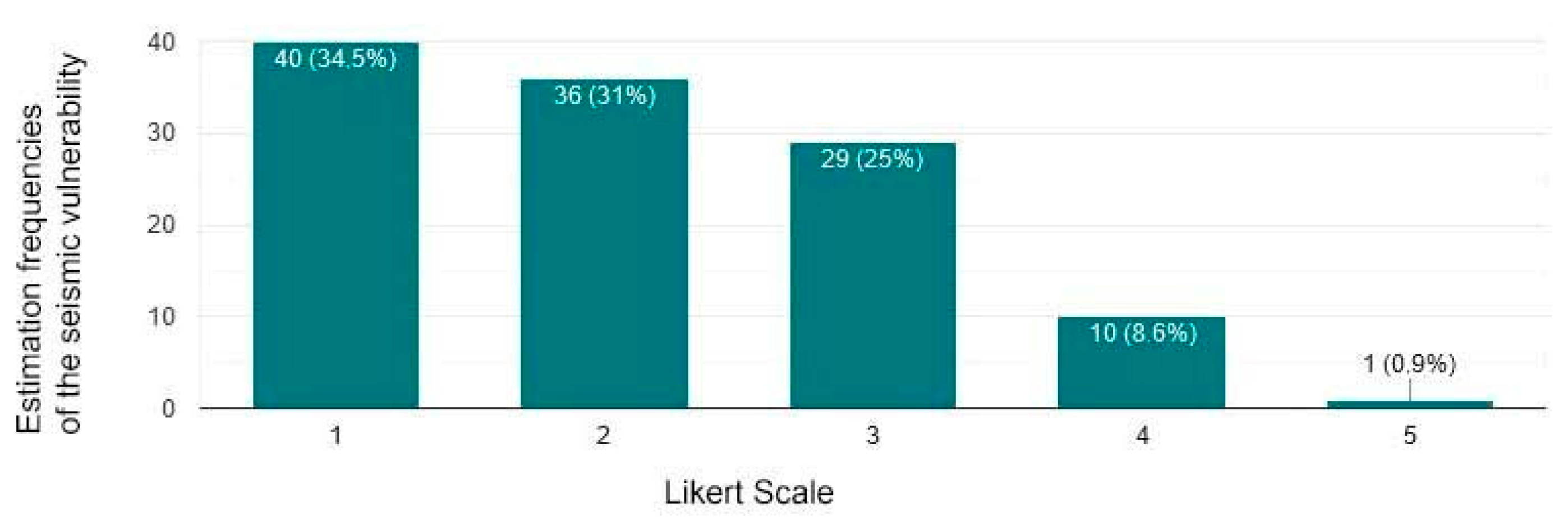

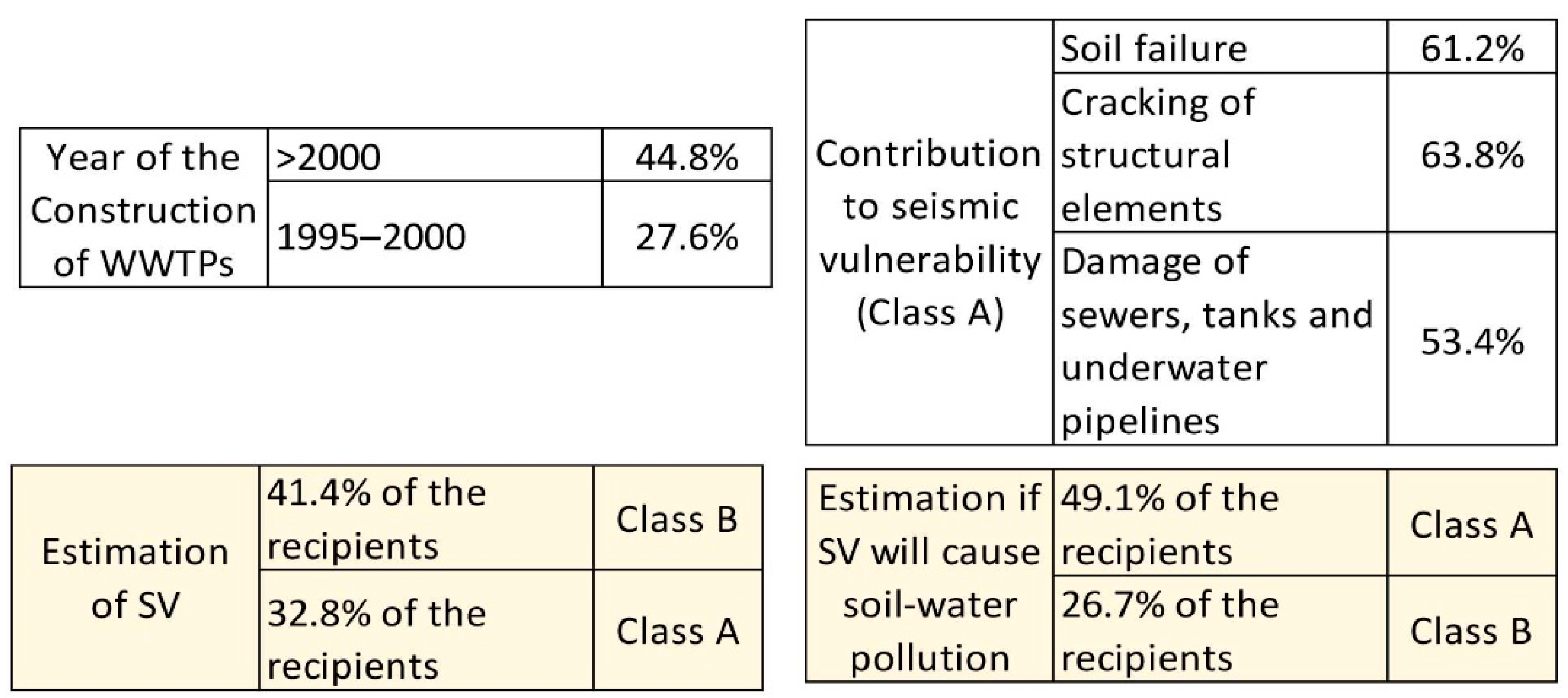
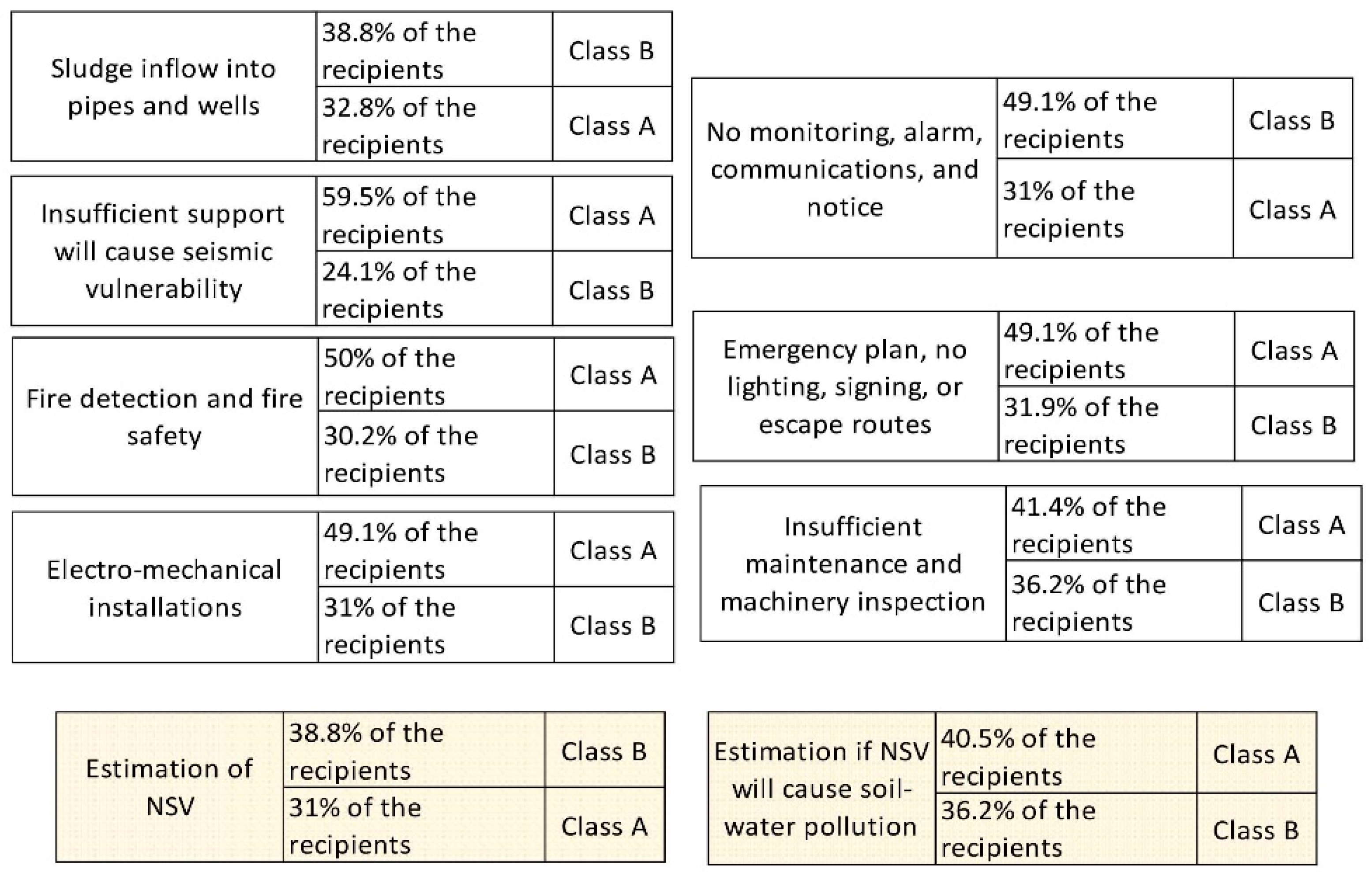
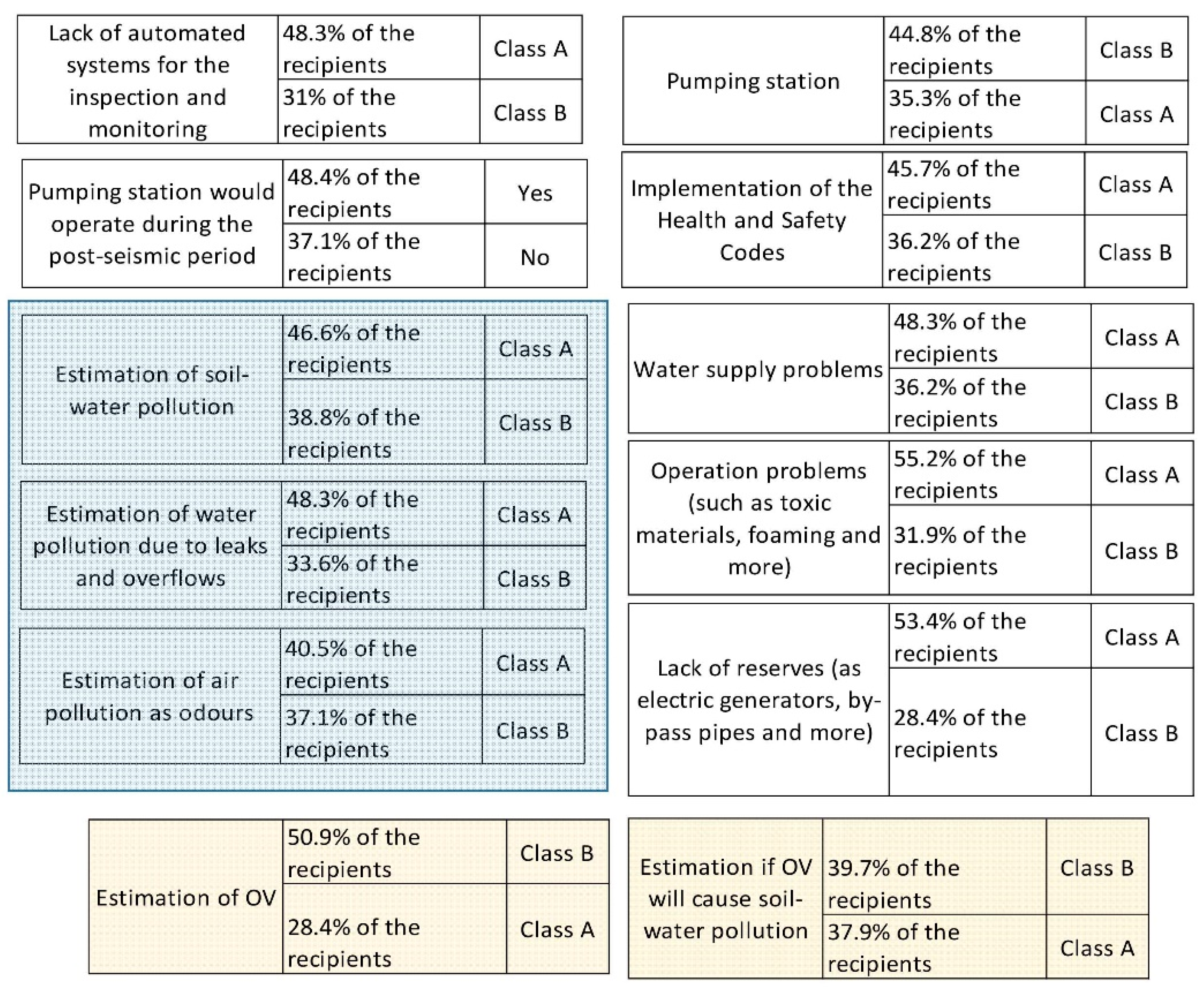

| Class | Classification According to Likert Scale | Percentages (%) |
|---|---|---|
| A | 1 | 0–20 |
| B | 2 | 20–40 |
| C | 3 | 40–60 |
| D | 4 | 60–80 |
| Ε | 5 | 80–100 |
| A/A | Categorization | Number of Existing WWTPs | Number of Examined WWTPs | Percentage (%) |
|---|---|---|---|---|
| 1 | Hazard Seismic Zone Ι | 96 | 38 | 39.80 |
| Hazard Seismic Zone ΙI | 136 | 78 | 56.40 | |
| Hazard Seismic Zone ΙII | 9 | 0 | 3.70 | |
| 2 | Secondary treatment | 37 | 18 | 15.40 |
| Tertiary treatment | 204 | 98 | 84.60 | |
| 3 | Capacity 2000–10,000 | 73 | 35 | 30.30 |
| Capacity 10,000–100,000 | 153 | 73 | 63.50 | |
| Capacity > 100,000 | 15 | 8 | 6.20 | |
| 4 | Sensitive receiving water body | 30 | 15 | 12.40 |
| Normal receiving water body | 211 | 101 | 87.60 |
| Seismic Vulnerabilities | Percentage of the Recipients (%) | Class |
|---|---|---|
| SV | 34.5 | A |
| NSV | 37.9 | A |
| OV | 27.6 | A |
| Descriptive Statistics | N | Minimum | Maximum | Mean | Std. Deviation |
|---|---|---|---|---|---|
| Questionnaire: Average of the Parts 2, 3, 4 (without trap-questions and direct questions) | |||||
| 116 | 1.17 | 3.52 | 1.8795 | 0.55311 | |
| Valid N (listwise) | 116 |
Publisher’s Note: MDPI stays neutral with regard to jurisdictional claims in published maps and institutional affiliations. |
© 2022 by the authors. Licensee MDPI, Basel, Switzerland. This article is an open access article distributed under the terms and conditions of the Creative Commons Attribution (CC BY) license (https://creativecommons.org/licenses/by/4.0/).
Share and Cite
Kerpelis, P.N.; Alexakis, D.E.; Golfinopoulos, S.K. A Qualitative Approach to the Seismic Estimation of Wastewater Treatment Plants and Potential Impacts on the Hydrosphere. Water 2022, 14, 3225. https://doi.org/10.3390/w14203225
Kerpelis PN, Alexakis DE, Golfinopoulos SK. A Qualitative Approach to the Seismic Estimation of Wastewater Treatment Plants and Potential Impacts on the Hydrosphere. Water. 2022; 14(20):3225. https://doi.org/10.3390/w14203225
Chicago/Turabian StyleKerpelis, Ploutarchos N., Dimitrios E. Alexakis, and Spyridon K. Golfinopoulos. 2022. "A Qualitative Approach to the Seismic Estimation of Wastewater Treatment Plants and Potential Impacts on the Hydrosphere" Water 14, no. 20: 3225. https://doi.org/10.3390/w14203225
APA StyleKerpelis, P. N., Alexakis, D. E., & Golfinopoulos, S. K. (2022). A Qualitative Approach to the Seismic Estimation of Wastewater Treatment Plants and Potential Impacts on the Hydrosphere. Water, 14(20), 3225. https://doi.org/10.3390/w14203225







